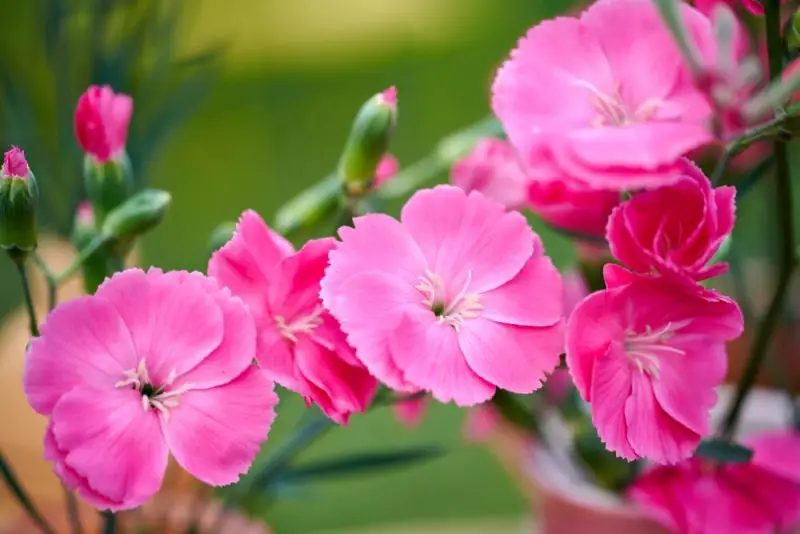Dianthus is a captivating garden flower, cherished for its vibrant colors, delicate fragrance, and long-lasting blooms. Its versatility makes it ideal for borders, containers, rock gardens, and even indoor displays. To grow dianthus successfully, gardeners must understand its specific needs, including sunlight requirements, soil type, and proper care techniques, ensuring strong, healthy plants that produce abundant flowers throughout the season.
Choosing the right location with well-draining soil and full sun exposure is crucial for optimal growth and vibrant blooms. Regular maintenance, including deadheading spent flowers, monitoring for pests, and providing occasional fertilization, encourages continuous flowering. With careful planning, seasonal adjustments, and consistent care, gardeners can enjoy a stunning display of colorful, fragrant dianthus, creating a visually captivating and fragrant garden that delights all season long.
Choosing the Right Dianthus Varieties

Selecting the right dianthus varieties is crucial for achieving a vibrant and long-lasting garden display. Dianthus comes in many types, including tall, upright, and compact spreading varieties, each with unique growth habits and bloom characteristics. Tall varieties are excellent for borders and cutting gardens, providing height and elegant flowers, while compact types are ideal for rock gardens, containers, or ground cover, creating dense, colorful mats. Understanding each variety’s growth habit helps gardeners plan garden layouts and companion planting to maximize visual impact.
Flower color and fragrance are also important considerations when choosing dianthus varieties. Colors range from deep reds, pinks, and purples to pure whites, allowing for creative color combinations and garden themes. Many varieties emit a sweet, clove-like fragrance, enhancing sensory appeal in outdoor spaces. Selecting varieties with staggered bloom times ensures continuous flowering throughout the season. By mixing early, mid, and late-blooming types, gardeners can maintain a consistent display of vibrant, eye-catching flowers that provide long-lasting beauty.
Adaptability and care requirements vary among dianthus varieties. Some prefer full sun and slightly alkaline soil, while others tolerate partial shade or different soil conditions. Knowing the preferred growing conditions of each variety prevents stress, promotes strong growth, and encourages abundant blooms. Disease resistance and hardiness should also influence selection, especially in regions prone to extreme weather or fungal issues. By carefully choosing the right varieties based on growth habit, color, fragrance, and environmental adaptability, gardeners can create a stunning, resilient, and continuously blooming dianthus garden.
Preparing the Soil and Planting Dianthus
Proper soil preparation is essential for healthy dianthus growth and abundant blooms. These flowers thrive in well-draining soil with a slightly alkaline to neutral pH. Before planting, loosen the soil to improve aeration and drainage, ensuring roots can expand easily. Adding organic matter, such as compost, aged manure, or finely shredded bark, enriches the soil with nutrients, encouraging strong root development, lush foliage, and vibrant flower production. Well-prepared soil sets the foundation for successful long-term growth and supports a prolonged blooming season.
Selecting the right planting location is equally important. Dianthus prefers full sun exposure for at least four to six hours daily, which encourages dense foliage and plentiful blooms. Avoid areas where water tends to collect, as soggy soil can cause root rot and reduce flower quality. Proper spacing between plants ensures good air circulation, limiting disease risk while promoting strong, upright growth. Planting at the correct depth, with the crown slightly above soil level, prevents crown rot and supports healthy development. Consider the surrounding environment, such as taller companion plants or garden structures, which can provide slight wind protection without shading the flowers excessively.
Planting techniques vary depending on whether you use seeds, seedlings, or transplants. Seeds should be started indoors six to eight weeks before the last frost, with gradual acclimation to outdoor conditions through hardening off. Transplants benefit from gentle watering immediately after planting to reduce stress, while mulching around newly planted dianthus helps retain moisture, suppress weeds, and regulate soil temperature. Regular monitoring of soil moisture and early intervention if drainage problems arise ensures that the plants establish quickly. By preparing the soil carefully, choosing the right location, and planting thoughtfully, gardeners set their dianthus up for long-lasting health, vigorous growth, and a consistently vibrant garden display throughout the season.
Watering and Fertilizing Dianthus
Proper Watering Techniques
Dianthus thrives when its soil remains consistently moist but not waterlogged. Overwatering can lead to root rot, while insufficient moisture stresses the plant and reduces bloom quality. The best approach is to water deeply once or twice a week, allowing the soil to dry slightly between watering. In hotter climates or during dry spells, additional watering may be necessary to prevent wilting. Early morning watering is ideal, as it allows leaves to dry during the day, reducing the risk of fungal diseases and encouraging healthy, vigorous growth.
Mulching around the base of the plant helps retain soil moisture and regulate root temperature. Organic mulches like shredded bark, compost, or straw prevent rapid evaporation and suppress weeds, reducing competition for water and nutrients. Consistent monitoring of soil moisture, especially after heavy rains or during heat waves, ensures that dianthus receives adequate hydration without oversaturation. Proper watering practices not only maintain plant health but also encourage continuous, vibrant flowering throughout the growing season.
Fertilization for Abundant Blooms
Regular fertilization supports strong growth and prolonged flowering in dianthus. A balanced, slow-release fertilizer with slightly higher phosphorus content encourages root development and abundant blooms. Applying fertilizer every four to six weeks during the growing season ensures a steady supply of nutrients without causing excessive foliage growth at the expense of flowers. Liquid fertilizers can also be used for a quick nutrient boost, particularly during peak blooming periods.
Avoid over-fertilizing, as excessive nitrogen can lead to lush green foliage but fewer flowers. Combining fertilization with proper watering enhances nutrient absorption and plant vitality. Additionally, incorporating organic matter such as compost or well-aged manure improves soil fertility, texture, and moisture retention, providing a natural and steady nutrient supply. By following consistent watering and fertilization practices, gardeners can maintain healthy dianthus plants with vibrant, long-lasting blooms that enhance garden beauty all season.
Pruning and Deadheading Dianthus
Deadheading for Continuous Blooms
Deadheading, or removing spent flowers, is essential for promoting continuous blooms in dianthus. Once flowers begin to fade, snip them off just above the first set of healthy leaves. This prevents the plant from diverting energy into seed production, allowing more resources to support new bud formation. Regular deadheading encourages a prolonged flowering season, keeps the plant looking neat, and enhances overall garden aesthetics. Maintaining a consistent deadheading schedule ensures that energy is focused on producing vibrant and numerous flowers rather than seed development.
In addition to removing faded flowers, deadheading reduces the risk of disease and pest infestations. Old blooms can harbor fungal spores or attract insects that may damage healthy foliage or flowers. By carefully inspecting each bloom before removal, gardeners can identify early signs of trouble and take preventive action. Deadheading also improves air circulation around the plant’s crown, which minimizes moisture retention and reduces fungal growth. Combining regular deadheading with proper watering, fertilization, and sunlight exposure maximizes bloom longevity and supports strong, resilient dianthus plants throughout the growing season.
Seasonal Pruning Techniques
Pruning dianthus helps maintain its shape, encourages bushier growth, and rejuvenates older plants. Light pruning can be done throughout the growing season to remove leggy stems, damaged leaves, or weak growth, promoting compact, healthy plants. More extensive pruning in early spring or after the main blooming period stimulates fresh growth and prepares the plant for another flowering cycle. This practice ensures continuous renewal and prevents the plant from becoming overgrown or sparse.
Pruning also improves air circulation within the plant, reducing the likelihood of fungal infections and pest infestations. Using clean, sharp tools ensures precise cuts, minimizes stress, and promotes quicker recovery. Removing older or weak stems allows sunlight to penetrate inner foliage, enhancing photosynthesis and overall plant vitality. By combining seasonal pruning with regular deadheading, proper watering, and fertilization, gardeners can maintain lush, vibrant dianthus with abundant blooms, ensuring a stunning, long-lasting display throughout the growing season.
Common Problems and Solutions
Pest Issues
Dianthus can attract several pests that affect plant health and flowering. Aphids, spider mites, thrips, and caterpillars are among the most common. These pests feed on leaves, stems, and flower buds, causing distorted growth, discoloration, or premature flower drop. Regular inspection, especially of leaf undersides and flower stems, helps detect infestations early. Early detection is key to preventing damage from spreading and reducing plant stress, ensuring continuous flowering and vibrant blooms.
Controlling pests involves both preventive and corrective measures. Introducing beneficial insects, such as ladybugs or predatory mites, naturally manages aphid and spider mite populations. Organic treatments like neem oil, insecticidal soaps, or horticultural oils can be used for persistent infestations without harming pollinators. Maintaining overall plant health through proper watering, pruning, and fertilization strengthens resistance to pest damage. By proactively addressing pest issues, gardeners can preserve the plant’s vigor, enabling dianthus to thrive and bloom profusely throughout the growing season.
Disease Management
Dianthus is susceptible to fungal diseases including powdery mildew, leaf spot, and root rot. Powdery mildew manifests as white, powdery patches on leaves, especially in humid conditions with poor air circulation. Root rot, often caused by waterlogged soil, leads to yellowing foliage, stunted growth, and eventual plant collapse. Early identification of these symptoms allows gardeners to intervene before severe damage occurs, protecting both plant health and flower production.
Preventive strategies include proper plant spacing, pruning, and ensuring adequate air circulation. Watering at the base instead of overhead minimizes leaf wetness, reducing fungal growth risk. Mulching helps regulate soil moisture and prevents splash-borne pathogens. Removing infected leaves promptly prevents disease spread. Using disease-resistant dianthus varieties and avoiding over-fertilization can also minimize susceptibility. By combining cultural practices, preventive care, and timely intervention, gardeners maintain healthy, vibrant dianthus with abundant blooms and prolonged flowering seasons.
Environmental Stress
Environmental factors such as extreme heat, frost, or prolonged drought can severely stress dianthus, reducing bloom quantity and quality. High temperatures can cause wilting, faded colors, or flower drop, while frost can damage buds, foliage, or even entire plants. Prolonged dry periods limit water uptake and nutrient absorption, leading to stunted growth. Monitoring weather conditions and providing appropriate protection, such as shade during hot afternoons or frost covers in early spring, helps mitigate stress and maintain plant vitality.
Soil quality and placement play a crucial role in stress tolerance. Well-draining soil prevents root waterlogging, while mulching retains moisture and regulates root temperature. Adjusting garden placement to avoid harsh winds or excessive sun exposure ensures healthier growth and more resilient flowering. Incorporating companion plants for microclimate regulation and consistent care further supports stress management. By addressing environmental challenges proactively, gardeners can sustain vibrant, long-lasting blooms and maintain the overall health and aesthetic appeal of dianthus plants throughout the growing season.
Enhancing Garden Design with Dianthus
Dianthus is an excellent choice for adding vibrant color and texture to garden designs. Its wide range of hues, from deep reds and pinks to soft whites, allows for creative combinations with other flowering plants. Planting dianthus in borders can define garden edges, while using compact varieties in containers or rock gardens creates eye-catching focal points. The plant’s low-growing habit also makes it ideal for filling gaps between taller perennials, contributing to a layered and dynamic landscape. Thoughtful placement enhances both aesthetic appeal and overall garden harmony.
Pairing dianthus with complementary plants can enhance visual impact and garden health. Plants with contrasting foliage colors or textures, such as silver-leaved artemisia or ornamental grasses, highlight dianthus blooms. Taller companion plants provide shelter from wind and create a sense of depth, while ground-cover companions help retain soil moisture and reduce weeds. Strategic color coordination ensures a seamless flow throughout the garden, extending visual interest from early spring through late summer. These design choices maximize the beauty of dianthus while supporting a balanced and resilient garden ecosystem.
Maintenance practices also contribute to effective garden design. Regular deadheading and pruning keep dianthus tidy and encourage continuous blooms, while proper spacing prevents overcrowding and disease. Mulching and soil amendments enhance plant health and sustain vibrant flowering. By thoughtfully integrating dianthus with other plants, textures, and seasonal color schemes, gardeners can create visually stunning displays that draw the eye and invite exploration. This approach ensures a lively, dynamic, and long-lasting garden filled with color, fragrance, and vitality throughout the growing season.
Extending the Blooming Season of Dianthus
Maintaining continuous blooms in dianthus requires strategic care and attention. Regular deadheading of spent flowers prevents the plant from diverting energy into seed production, allowing more resources to support new bud formation. Removing old blooms also helps maintain plant appearance and promotes a neat, tidy garden. Consistent pruning of leggy stems encourages compact growth, enhancing airflow and reducing disease risk. By combining deadheading with proper pruning, gardeners can extend the flowering period, ensuring vibrant color throughout the growing season.
Seasonal adjustments play a crucial role in prolonging blooms. In warmer climates, providing light afternoon shade protects dianthus from excessive heat, which can cause flower drop and fading colors. During cooler periods, mulch around the plant helps regulate soil temperature, conserve moisture, and protect roots from early frost. Timing fertilization to coincide with peak growth periods encourages robust flowering. Balanced, slow-release fertilizers or periodic liquid feeding provide essential nutrients that support repeated blooming and healthy plant development.
Water management is another key factor in extending the flowering season. Dianthus prefers evenly moist soil but does not tolerate waterlogged conditions. Regular watering, combined with mulch to retain moisture, prevents stress that can inhibit bud formation. Monitoring soil moisture and adjusting irrigation during dry spells ensures plants remain healthy and productive. By implementing these strategies—deadheading, pruning, seasonal adjustments, fertilization, and proper watering—gardeners can enjoy long-lasting, vibrant dianthus displays that enhance the beauty and charm of any garden throughout the entire growing season.
Propagating Dianthus for More Plants
Propagating dianthus allows gardeners to expand their garden, share plants, or rejuvenate older specimens. There are several methods for propagation, including seed sowing, cuttings, and division. Seeds offer a cost-effective way to produce numerous plants and are ideal for starting new varieties. They should be sown indoors six to eight weeks before the last frost, in well-draining seed-starting mix. Maintaining consistent moisture and warmth ensures high germination rates and healthy seedlings ready for transplanting.
Cuttings provide a quicker method to clone existing plants while preserving desirable traits. Softwood or semi-hardwood cuttings taken in spring or early summer root readily when placed in a well-draining medium and kept under humidity. Using a rooting hormone can improve success rates. Regular monitoring of moisture and light conditions supports root development and healthy growth. Once roots establish, cuttings can be transplanted into garden beds or containers, contributing to extended bloom displays.
Division is an effective method for rejuvenating older, crowded dianthus plants. Mature clumps can be lifted in early spring or after flowering, carefully separated into smaller sections with roots intact, and replanted immediately. Dividing plants improves airflow, reduces disease risk, and encourages vigorous growth and flowering. By combining seed propagation, cuttings, and division techniques, gardeners can increase their dianthus population, maintain continuous blooms, and ensure a vibrant, colorful garden throughout the growing season.
Overwintering Dianthus
Protecting dianthus during the winter months is essential for ensuring healthy regrowth and vibrant blooms in the following season. While some varieties are hardy perennials, others may be more sensitive to frost or prolonged cold. In colder regions, gardeners should provide extra protection by applying a layer of mulch around the base of the plants. Organic materials such as straw, shredded leaves, or pine needles help insulate roots, regulate soil temperature, and retain moisture. Proper winter care reduces plant stress and enhances survival rates during freezing temperatures.
Container-grown dianthus requires special attention in winter. Pots should be moved to sheltered locations, such as a garage, greenhouse, or near the home’s foundation, where temperatures remain above freezing. Reducing watering is important, as dormant plants require minimal moisture, but the soil should never completely dry out. Light exposure is also a consideration; placing containers in areas with indirect sunlight prevents etiolation while maintaining dormancy. By monitoring conditions and adjusting care routines, container dianthus can survive winter and resume healthy growth in spring.
Pruning and cleaning up the garden before winter contributes to successful overwintering. Remove dead or diseased stems and foliage to prevent pests and fungal infections from overwintering in plant debris. Light pruning encourages a tidy, manageable plant structure, making spring regrowth more vigorous. Gardeners can also plan companion planting or garden layouts that provide natural windbreaks and microclimate protection. By implementing these winter strategies, both garden bed and container dianthus thrive year after year, producing strong, healthy, and continuous blooms throughout each growing season.
FAQ About How to Grow Dianthus
What is the best soil type for growing dianthus?
Dianthus thrives in well-draining soil with a slightly alkaline to neutral pH. Loamy or sandy soil enriched with organic matter encourages strong root development and abundant blooms. Good drainage prevents root rot, while soil fertility ensures healthy foliage, vibrant flowers, and a prolonged blooming season. Regularly amending soil with compost enhances nutrient availability.
How much sunlight do dianthus plants need?
Dianthus requires at least four to six hours of full sun daily to maintain compact growth and promote flowering. Insufficient sunlight results in leggy stems, reduced blooms, and weaker plants. In hot climates, providing light afternoon shade can prevent flower fading and heat stress. Proper sunlight exposure enhances color intensity and fragrance.
How often should I water dianthus?
Water dianthus regularly to keep the soil evenly moist but never waterlogged. Deep watering once or twice a week is usually sufficient, with adjustments during hot or dry periods. Mulching helps retain soil moisture and reduces evaporation. Avoid wetting foliage to prevent fungal diseases and encourage healthy, vibrant blooms.
When should I fertilize dianthus?
Fertilize dianthus every four to six weeks during the growing season using a balanced, slow-release fertilizer. Liquid feeding can be applied during peak bloom for a nutrient boost. Avoid excessive nitrogen, which promotes foliage over flowers. Combining fertilization with proper watering maximizes growth and ensures continuous flowering.
How can I protect dianthus during winter?
In colder climates, protect dianthus by applying a thick mulch layer around the base or moving container plants to a sheltered area. Reduce watering during dormancy, remove dead stems, and prune lightly to maintain plant health. These strategies prevent frost damage and support strong regrowth and vibrant blooms in spring.
Conclusion
Growing dianthus successfully requires attention to soil, sunlight, watering, and proper care techniques. By selecting the right varieties, preparing well-draining soil, and providing consistent watering and fertilization, gardeners can enjoy vibrant, long-lasting blooms. Regular deadheading and pruning maintain plant health and encourage continuous flowering throughout the season. Propagation through seeds, cuttings, or division expands the garden while overwintering strategies protect plants from harsh weather. Combining these practices ensures a thriving dianthus display, enhancing garden aesthetics with color, fragrance, and texture. With careful planning and consistent care, dianthus can flourish year after year, providing enduring beauty.






